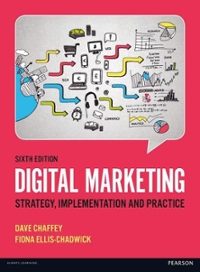This case is about the social network Facebook, which hardly needs an introduction. However, when we first
Question:
This case is about the social network Facebook, which hardly needs an introduction. However, when we first featured it in an earlier edition of his text, it was a niche service mainly used in colleges and universities. It is still a good case study in that it shows many of the success factors needed for launch of a new digital business, along with the risks of alienating users when their privacy needs are not listened to. It’s incredible that it now has more than a billion monthly active users worldwide, yet has fewer than 5000 employees.
In 2015, the Facebook mission as stated on its company page is simply: ‘We want to give you the power to share and to make the world more open and connected’. Previously, Facebook described itself in a more functional sense as
a social utility that helps people communicate more efficiently with their friends, family and coworkers. The company develops technologies that facilitate the sharing of information through the social graph, the digital mapping of people’s real-world social connections. Anyone can sign up for Facebook and interact with the people they know in a trusted environment.
You may well have seen the 2010 film The Social Network, which describes how Facebook was founded while Mark Zuckerberg was a student at Harvard University. Initially membership was limited to Harvard students. The initial viral effect of the software was indicated since more than half of the undergraduate population at Harvard registered on the service within the first month! Zuckerberg used open-source software PHP and the MySQL database to create the original ‘TheFacebook.com’ site and these technologies are still in use today. The film also describes the long-running dispute on ownership of Facebook since another Harvard-originated social networking site ‘HarvardConnection’, which later changed its name to ConnectU, alleged in September 2004 that Zuckerberg had used their source code to develop Facebook when they originally contracted him to help in building their site.
When Facebook first launched in February 2004, there were just three things that users could do on the site which are still core to its functionality. Users could create a profile with their picture and information, view other people’s profiles, and add people as friends. The latest SEC update (2014) explains these core consumer benefits defined by the company:
● Connect and share with your friends. Staying connected is the core feature as we would expect, but note the more emotional underpinnings of the other elements of the value proposition.
● Discover and learn. Facebook references public figures and organisations that interest them – available through Facebook company pages.
● Express yourself. A fundamental need. Facebook does this through its key features which it describes as the Timeline, News Feed, Photos and Videos and messaging through Email, Chat and Text.
● Stay connected everywhere. Referencing the importance of mobile use and use on other sites to Facebook’s users and business model: People can access Facebook through the website, mobile sites, smartphone apps, and feature phone products.
Questions
1 As an investor in a social network such as Facebook, which financial and customer-related metrics would you use to assess and benchmark the current business success and future growth potential of the company?
2 Complete a situation analysis for Facebook focussing on an assessment of the main business risks which could damage the future growth potential of the social network.
3 For the main business risks to Facebook, suggest approaches the company could use to minimise these risks.
Step by Step Answer:





